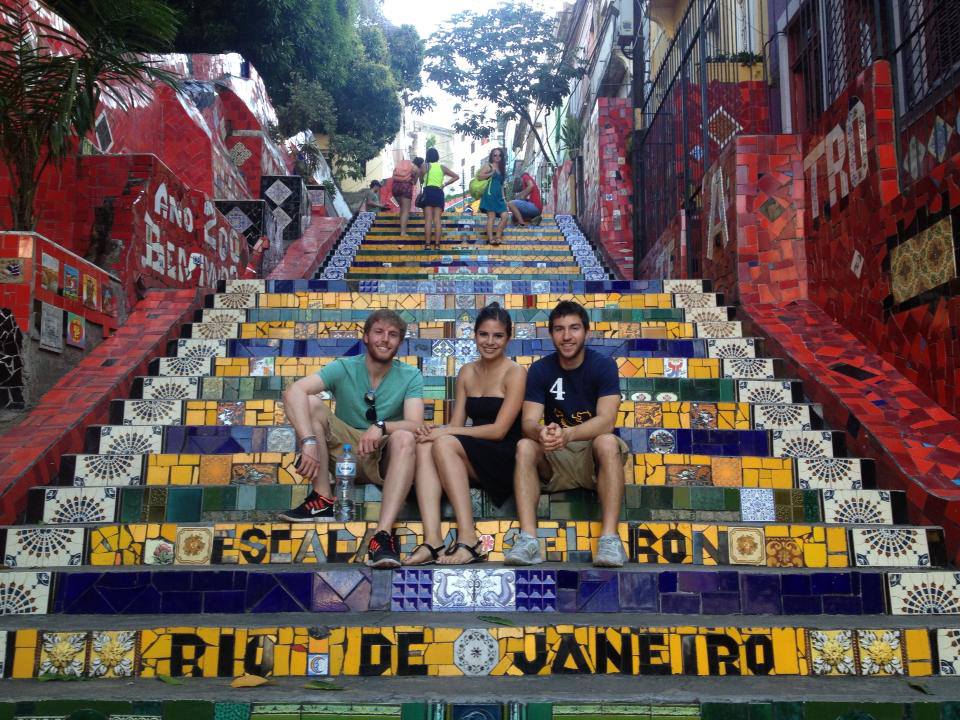To cut to the chase: Rio de Janeiro, Brazil, is up there for my favorite places in the world. Our week in the Marvelous City was indeed marvelous, although I unfortunately didn't take my camera out often (I didn't want to lose it to a pickpocket). As for why I loved Rio, here's a few reasons that come to mind:
1. Beautiful beaches. You just can't beat long, wide, white beaches carved out of luscious green mountains.
2. Beautiful people. Everything you have heard about Brazil having a lot of beautiful people is true. The people here are tan, fit, and the products of a great melting pot of ethnicities. There's actually a good amount of psychological research that indicates people find computer "averaged" faces more beautiful -- I wouldn't be surprised if mixing lots of races achieves this effect too.
3. A happy, care-free attitude. Especially compared to the giant metropolis of Sao Paulo, any Brazilian will tell you that the people here are easy-going. Just walking around the streets, I have seldom seen so many happy and friendly people.
4. An emphasis on fitness and sport. Every beach is lined with sand soccer fields and volleyball courts. There are also always thousands of people running, biking, and skating along the boardwalks.
5. Easy access to trails, gardens and nature. There are lots of parks, gardens and trails here. Like most humans, I love being surrounded by greenery.
6. Good, fresh food. Rio is right next to the sea + in a tropical region + in a country with lots of livestock. The result is tasty seafood, amazing fruit, and superb steak.
7. Enjoyable music. This may apply to Brazil more as a whole, but there's pretty good music here. The Jorge Ben Jor concert we went to was exactly what I was looking for -- an awesome fusion of samba, rock, funk and bossa nova. He's pretty old, but the young Brazilians love him as much as their parents do.
8. Hoppin' nightlife. We had a lot of nights when the sun was out before we got back home. A central area called Lapa is crawling with Brazilians looking for a good time at one of the city's countless bars and clubs. We also explored a few other venues, like going to a giant "Favela Funk Party" inside one of the slums.
As for things that affect quality of life and daily living, it's hard to top Rio's offerings. There's a lot of people that move here after visiting, and I wouldn't rule out coming back someday.
What's missing? Compared to some of my other favorite cities in the world, it's missing the deep, rich history that Istanbul has and it's missing the sleekness and modernity that Hong Kong has. It also doesn't have quite as many museums and cultural offerings compared to other bigger cities (although we did love our visit to the city's Modern Art Museum).
Lastly, and most detrimentally, there is undeniable inequality here. The main Zona Sur is wonderful and mostly clean, but the city is surrounded by favelas (slums) that have been mostly left out of Brazil's economic progress. While the country has the strongest affirmative action policies in the world and other efforts to combat inequality, many Brazilians are cynical their effectiveness so far. Nonetheless, most people seem to think things are very slowly getting better for the poor.
The famous Lapa steps were made by Chilean Jorge Selaron as a tribute to the Brazilian people. The steps are made from thousands of tiles from all over the world, including even Minnesota. Copacabana Beach, down the street from our hostel.
Copacabana Beach, down the street from our hostel.
 Copacabana Beach, down the street from our hostel.
Copacabana Beach, down the street from our hostel.
Christ the Redeemer.
We had an awesome crew at our hostel. Here a few of us eating at Porcao, a Brazilian steakhouse.
I'm not sure who saw and who did.
Sculptures in Santa Teresa, the Bohemian area of town
Sunset from Sugarloaf mountain.
Christ overlooking the city.
The beach is chock-full of soccer fields. Talk about paradise.
Lots of green space.
All the inlets and curving shorelines make for an inordinate amount of beach.
We hiked Dois Irmaos, the mountain overlooking Ipanema. To get to the bottom of it, we took motorbike taxis through one of the slums on the outside of the city -- an exciting ride and a cool climb.
Ipanema from the mountain.
Snoop Dogg and Pharell appropriately filmed their hit song, "Beautiful," in Rio.
After a traditional homemade Brazilian dinner at our friend Laura's apartment, we spent the night listening to her roommates play Niel Young and Johnny Cash. Too bad we have to leave Brazil, but South Africa awaits!
















































































